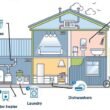In 2025, creating a fire-safe workplace goes far beyond basic compliance, but rather involves a comprehensive and proactive approach. As fire-safety legislations evolve it is crucial that businesses are constantly assessing risks and updating their emergency response plans, to prioritise the safety of their employees. This guide will take you through the key best practices that businesses must take in 2025 to ensure their workplace will be prepared in the event of a fire.
Understanding Fire Safety Compliance
In order to understand fire safety compliance in your workplace it is important to stay up to date with current fire safety legislation and regulations. In England and Wales workplaces primarily follow the 2005 regulatory reform (fire safety) act. It’s important for businesses to follow this legislation closely and perform regular fire safety audits to ensure that the workplace meets 2025 standards. Fire safety audits aren’t just formalities but equally as important for continuously improving workplace safety.
Maintaining Fire Safety Equipment
Fire Extinguishers: Once a month visually inspect fire extinguishers for damage and verify the tamper seal and safety pin are intact. Ensure that it is in its designated location at all times and plan annual professional inspections.
Smoke Detectors and Fire Alarms: Test smoke detectors and fire alarms monthly and replace the batteries annually or when they are running out. If your fire alarms or smoke detectors are more than ten years old, they should be replaced immediately.
Sprinkler Systems: Ensure that sprinkler systems remain unobstructed at all times and undertake annual professional inspections.
Fire Doors: Undertake monthly inspections to check fixings are secure, seals are in good condition and there is no visible damage. Lubricate door hinges and panic hardware, and wipe the door frame with warm soapy water.
Emergency Lighting: Test emergency lighting regularly to check it is working efficiently and replace batteries a minimum of every four years.
Assessing Workplace Fire Hazards
To effectively assess workplace fire hazards a structured risk assessment framework must be used, this involves following five key steps:
Identify fire hazards
A fire hazard refers to anything that can start a fire, this includes:
- Ignition sources. i.e. electrical equipment, cigarettes
- Combustible materials. i.e. wood, cardboard boxes, gasoline
Identify the people at risk
- Identify how many people are in the premises and if there are any disabled or young individuals in the premises.
Evaluate and act
- Identify the number of entry and exit points in the building.
- How many floors, staircases and corridors are in the building.
- Does the building have the appropriate number of fire extinguishers, fire exit signs or fire alarms.
Record and train
- Complete a physical fire risk assessment to keep a record of it.
- Create a fire safety plan by organising regular fire drills and training staff members.
- Create a checklist and time schedule for your plan.
Review
- Regularly review and update your fire risk assessment if there are any changes.
Fire Prevention Strategies
To mitigate fire risks in workplaces, organisations must conduct a multilayered approach, involving the following strategies:
Implementing strict policies: Flammable materials must be stored in non-combustible containers and away from heat sources. Policies must be outlined for the safe use and disposal of flammable items and this must be monitored at all times.
Regular fire drills: Conduct realistic and thorough fire drills a minimum of once a year, if not once a quarter, and continually analyse the results for improvement.
Training staff members: All employees must undergo thorough training regarding evacuation procedures and the use of fire safety equipment, to ensure compliance with fire safety regulations.
Regularly testing fire equipment: All fire safety equipment, such as smoke detectors, extinguishers and sprinklers, must be well-maintained and regularly tested.
Emergency Response and Evacuation Plans
In the event of a fire, it is vital that workplaces have a well-planned emergency response and evacuation plan in place. This can be done by mapping out clear evacuation routes, practising fire drills twice a year and ensuring that there are visible exit signs to guide staff during emergencies. Vulnerable members of staff may require further assistance when evacuating, so it is crucial that workplaces have personal emergency evacuation plans (PEEP) in place for these individuals.
Workplace Layout and Floor Plans
Always provide accurate and up to date floor plans of your workplace, that clearly show each level with defined access points, assembly areas and fire safety equipment. These plans must be clear and electronically available so that they can be accessed by first responders in the event of an emergency.
Furthermore, if possible, avoid an open-plan workplace layout where possible as the absence of walls can significantly increase the severity of a fire in the workplace. Walls and doors act as a crucial barrier for smoke and fire, providing more time for staff members to safely escape the building in the event of a fire.
Finally, signage should be visible from every angle and positioned no less than 1.8 metres above floor level. In addition, fire extinguishers must be placed near exits and high-risk areas, for instance near any electrical equipment. There should be a minimum of two class A extinguishers per floor and at least one fire extinguisher within a 30-metre radiance from all points in the building.
In conclusion, creating a fire-safe workplace in 2025 involves a proactive and tailored approach that prioritises following the most up to date legislation and conducting regular risk assessments. The latest best practices involve assessing fire hazards and prevention strategies, maintaining fire equipment, creating a thorough emergency response plan and considering workplace layout. By following these protocols workplaces can ensure that they are putting their best foot forward to protect their staff members and business assets.









Heard some buzz about kingjl. Decided to check it out myself. Not bad, not amazing. What’s everyone else’s take on this one?
Been messing around on eu88bet for a while now. I gotta say, their customer support is surprisingly helpful. Had a small issue with a withdrawal, and they sorted it out quick. Games are decent, nothing crazy but reliable. Worth a try, especially if you value good support: eu88bet.
If you’re looking for games, try gamesx66. It’s got a nice selection. The graphics are pretty good and load times are fast! gamesx66
OKVIP 99 looks promising, although I’m not entirely sure about the details yet. The site layout is decent. Keep an eye on it: okvip99
Heard about bet88affiliates, decided to check it out. If you’re looking to partner up, might be worth a look. Seems like they have a decent program. Do your research though! Learn more: bet88affiliates
Looking for the top Jili games? bestjiligames has got you covered. I’ve found some real gems on there. Take a look! : bestjiligames
Gave affun a whirl last night. Had a good time! Some unique games I hadn’t seen before. Worth a look if you’re looking for something different. affun